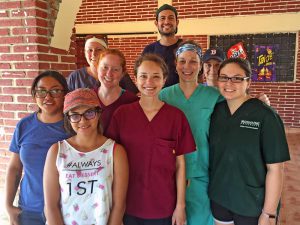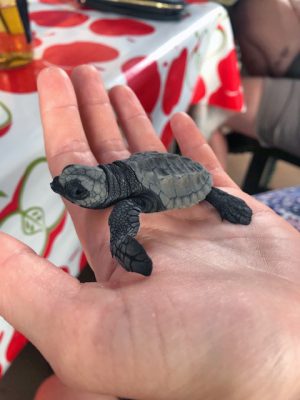Featuring Jamie Welker, DVM Class of 2019

I had aspirations to advance my surgical techniques, practice my Spanish language skills, and learn about the sea turtle population in the area through the Mazunte Project. However, throughout my time in Mazunte, it became clear that those aspirations were only scratching the surface. The Mazunte project, now in its nineteenth year of existence, has grown to incorporate more than 50 volunteers from all over North America, including Vermont, Massachusetts, Colorado, Michigan, and British Columbia. The program was created with the goal of reducing the number of predatory species with access to sea turtle nests. These species included stray and hungry canines, sea bird populations, and scarab beetles. Created by veterinarian Richard Roger, the initial plan was to implement a canine population control program through the sterilization of dogs, both stray and owned. The program has not only succeeded in population control, but also in changing local cultural ideals toward sterilization through the program’s client education.

This program could not be successful without teamwork. The group from Michigan State included Dr. Pierre DePorre, Dr. Emery Engers, Jill Grogan, Pedro Soto, Melissa Santonocito, and me. The team acknowledged each other’s strengths, and the process of patient pre-medication, preparation, surgery, and recovery quickly became streamlined. This was essential due to the limited resources and the rural environment in which we were stationed. We watched over one other, making sure each person took breaks for water and food due to the extreme temperatures that Oaxaca, Mexico delivered. This environment provided unique circumstances not frequently encountered by veterinary medical students; I am grateful for the experience.
Stationed in Mazunte, I was able to appreciate the Mexican culture and practice the Spanish language. Development of veterinary terminology in a foreign language was a key component to this program. Each conversation, whether with a client or local shop owner, helped me practice and become more comfortable with the language. During our trip, we also were able to observe the El Día de los Reyes holiday, a Christmas related celebration of the three kings who brought gifts to the infant Jesus. We enjoyed the carnival held in the local town square and a celebratory firework show as well.

Access to international programs, including the Mazunte project, is essential for the formation of well-rounded veterinarians. It pushes veterinary medical students to be resourceful, patient, and to think outside of the box. The cultural immersion helps enlighten students to foreign legislation, adapt to new and difficult client expectations, and emphasize client communication. This project also was a welcome relief for these rural areas to receive veterinary services, which aren’t always accessible or affordable. Beyond the sterilization of the dogs and cats, we were able to provide deworming treatments, perform a laceration repair, and replace a uterine prolapse! These experiences were only possible through the coordination between the MSU College of Veterinary Medicine and the Mazunte Project. I will forever be thankful for this experience.
